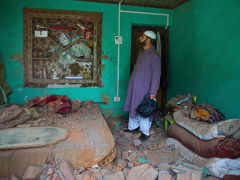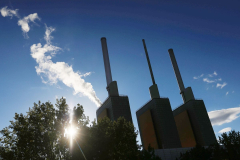Srinagar, Indian-administered Kashmir — On Saturday morning at Fateh Kadal, a densely packed neighbourhood on the sloping embankment of the Jhelum River in Srinagar, Indian-administered Kashmir’s largest city, 62-year-old Hajira wrapped a cotton scarf with a brown paisley design around her shoulders.
With her face muscles tense and sweat beading across her upper lip, she sat on the cement floor of a government-run grains store.
“Can you make it quick?” she called to the person manning the store.
Hajira comes to the store every month to submit her biometric details, as required by the government to secure the release of her monthly quota of subsidised grains, which her family of four depends on.
But this time was different. The past few days have been unprecedented for residents of Indian-administered Kashmir. Drones hovered overhead, airports were shut down, explosions rang out, people were killed in cross-border fire, and the region prepared for the possibility of an all-out war.
“He made me stand in the queue,” she said, flinching from knee pain, referring to the store operator. “But there’s uncertainty around. I just want my share of rice so I can quickly return. A war is coming.”
Then, on Saturday evening, Hajira breathed a sigh of relief. United States President Donald Trump announced that he had succeeded in mediating a ceasefire between India and Pakistan.
“I thank God for this,” Hajira said, smiling sheepishly. “Perhaps he understood that I didn’t have the means to endure the financial hardship that a war-like situation would have caused.”
On Sunday morning, Trump went a step further, saying in a post on his Truth Social platform that he would try to work with India and Pakistan to resolve their longstanding dispute over Kashmir, a region both countries partly control but claim in its entirety.
Political analyst Zafar Choudhary, based in the city of Jammu in southern Kashmir, told Al Jazeera that New Delhi would not be happy about Trump’s statement. India has long argued that Pakistan-sponsored “terrorism” is the primary reason for tensions between the nuclear-armed neighbours.
However, “Trump’s offer underlines the fact that Kashmir remains central to India-Pakistan confrontations”, Choudhary said.
And for Kashmiris, the hope stemming from the fragile pause in fighting between India and Pakistan, and Trump’s offer to mediate talks on Kashmir, is tempered by scepticism borne from a decades-long, desperate wait for peace.

‘Never been more frightened’
Hundreds of thousands of Kashmiris stood in the direct line of fire between India and Pakistan in recent days.
As the neighbouring nations launched missiles and drones at each other, Kashmiri communities near the Line of Control (LoC), the de facto border with Pakistan, also witnessed cross-border shelling on a scale unseen in decades, triggering an exodus of people towards safer locations.
The shadow of conflict has stalked their lives for nearly four decades, since an armed rebellion first erupted against the Indian government in the late 1980s. Then, in 2019, the government scrapped Kashmir’s semi-autonomous status amid a huge security crackdown – thousands of people were imprisoned.
On April 22, a brutal attack by gunmen on tourists at Pahalgam killed 26 civilians, shattering the normalcy critics had accused India of projecting in the disputed region.
Since then, in addition to a diplomatic tit-for-tat and missile exchanges with Pakistan, the Indian government has intensified its crackdown on the armed groups active in Kashmir.
It has demolished the homes of rebels accused of links to the Pahalgam attack, raided other homes across the region and detained approximately 2,800 people, 90 of whom have been booked under the Public Safety Act, a draconian preventive detention law. The police also summoned many journalists and arrested at least one for “promoting secessionist ideology”.
By Sunday, while a sense of jubilation swept through the region over the ceasefire, many people were still cautious, doubtful even, about whether the truce brokered by Trump would hold.
Just hours after both countries declared a cessation of hostilities, loud explosions rang out in major urban centres across Kashmir as a swarm of kamikaze drones from Pakistan raced across the airspace.
Many residents raced to the terraces of their apartments and homes to capture videos of the drones being brought down by India’s defence systems, a trail of bright red dots arcing across the night sky before exploding midair.
As part of the emergency protocols, the authorities turned off the electricity supply. Fearing that the debris from drones would fall on them, residents ran for safety. The surge of drones through the night skies also touched off sirens, triggering a sense of dread.
“I don’t think I have ever been more frightened before,” said Hasnain Shabir, a 24-year-old business graduate from Srinagar. “The streets have been robbed of all their life. If the prelude to war looks like this, I don’t know what war will look like.”

A fragile ceasefire
Hours after the ceasefire was announced on Saturday, India accused Pakistan of violating it by shelling border regions. Residents across major towns in Kashmir were on their toes, once again, after drones reappeared in the skies.
One of the worst-affected places in Kashmir during these days is Uri, a picturesque town of pear orchards and walnut groves close to India’s contested border with Pakistan.
The vill





